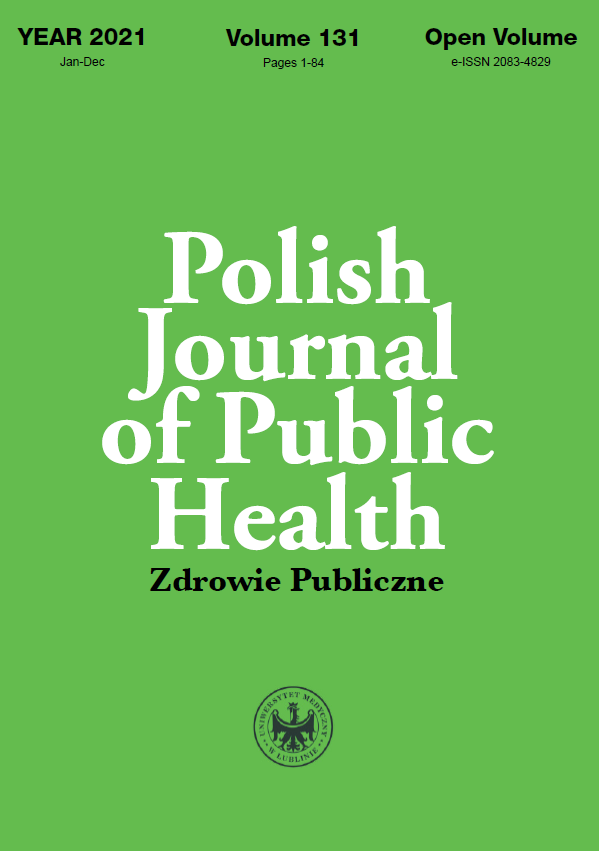How do the officials sleep? The assessment of sleep of the public administration workers using objective and subjective methods
DOI:
https://doi.org/10.2478/pjph-2021-0006Keywords:
official, sleep, sleep disorders, actigraphyAbstract
Sleep impacts our functioning, both on a physical and mental level. This study aimed to assess the officials’ sleep using objective (actigraphic examination) and subjective evalutation methods (self-administered questionnaire and sleep diary).
The analysis revealed that among the officials, sleep deprivation was common. The average actual sleep time in this group was 1-hour shorter than recommended. Officials holding managerial positions more frequently presented worse sleep outcomes affecting their sleep efficiency than lower-level office workers. Workplace stress was associated with reduced sleeping hours and household stress with more frequent night waking.
References
1. Youngstedt SD, Goff EE, Reynolds AM, et.al. Has adult sleep duration declined over the last 50+ years? Sleep Med Rev. 2016;28:69-85.
2. Knutson KL, Spiegel K, Penev P, et al. The metabolic consequences of sleep deprivation. Sleep Med Rev. 2007;11(3):163-78.
3. Lau K, Piórkowska K, Marcinkowska U, et al. Senność dzienna oraz jakość snu u osób z nadwagą i otyłością. Endokrynol Otył Zab Przem Mat. 2013;9(1):1-7.
4. Morselli L, Leproult R, Balbo M, et al. Role of sleep duration in the regulation of glucose metabolism and appetite. Best Pract Res Clin Endocrinol Metab. 2010;24(5):687-702.
5. Leproult R, Van Cauter E. Role of sleep and sleep loss in hormonal release and metabolism. Endocr Dev. 2010;17:11-21.
6. Born J, Wilhelm I. System consolidation of memory during sleep. Psychol Res. 2012;76:192-203.
7. Stickgold R. Sleep-dependent memory consolidation. Nature. 2005;437:1272-8.
8. Irwin MR. Why sleep is important for health: a psychoneuroimmunology perspective. Annu Rev Psychol. 2015;66:143-72.
9. Besedovsky L, Lange T, Haack M. The sleep-immune crosstalk in health and disease. Physiol Rev. 2019;99(3):1325-80.
10. Irwin MR. Human psychoneuroimmunology: 20 years of discovery. Brain Behav Immun. 2008;22(2):129-39.
11. Iliff JJ, Wang M, Liao Y, et. al. A paravascular pathway facilitates CSF flow through the brain parenchyma and the clearance of interstitial solutes, including amyloid β. Science Transl Med. 2012;4(147). https://doi.org/10.1126/scitranslmed.3003748
12. Nollet M, Wisden W, Franks NP. Sleep deprivation and stress: a reciprocal relationship. Interface Focus. 2020;10(3):20190092.
13. Goldstein AN, Walker MP. The role of sleep in emotional brain function. Annu Rev Clin Psychol. 2014;10:679-708.
14. Kowalska A. Mózg a sen. Neurolingwistyka w patologii i zdrowiu. Pomorski Uniwersytet Medyczny w Szczecinie. Sympozja II; 2013. p.80-3.
15. Kiciński P, Przybylska-Kuć SM, Tatara K, et al. Wiarygodność Skali Senności Epworth i Kwestionariusza Berlińskiego w diagnostyce przesiewowej zespołu obturacyjnego bezdechu sennego w kontekście badań kandydatów na kierowców. Med Pr. 2016;67(6):721-8.
16. Sińczuk-Walczak H, Siedlecka J, Szymczak W, et al. Objawy i zespoły neurologiczne u kierowców pojazdów komunikacji miejskiej. Med Pr. 2015;66(3):333-41.
17. Lemke MK, Apostolopoulos Y, Hege A, et al. Work, sleep, and cholesterol levels of U.S. long-haul truck drivers. Ind Health. 2017;55(2):149-61.
18. Pasierb N, Filipczyk K, Kunert Ł, et al. Bezsenność u pracowników zmianowych huty cynku. Med Pr. 2019;70(5):611-6.
19. Burdelak W, Pepłońska B. Praca w nocy a zdrowie pielęgniarek i położnych – przegląd literatury. Med Pr. 2013;64(3):397-418.
20. Lau K, Kasperczyk J, Tyrpień M, et al. Czas pracy lekarzy. Wybrane aspekty prawne i praktyczne związane z ponadwymiarowym obciążeniem pracą. III Ogólnopolska Konferencja Naukowa: Psychologia, medycyna i prawo w zawodach trudnych i niebezpiecznych. Katowice 7-8.06.2018 (book chapter).
21. Barger LK, Sullivan JP, Blackwell T, et al. Effects on resident work hours, sleep duration, and work experience in a randomized order safety trial evaluating resident-physician schedules (ROSTERS). Sleep. 2019;42(8). https://doi.org/10.1093/sleep/zsz110
22. Kalmbach DA, Arnedt JT, Song PX, et al. Sleep disturbance and short sleep as risk factors for depression and perceived medical errors in firstyear residents. Sleep. 2017;40(3):zsw073. https://doi.org/10.1093/sleep/zsw073
23. Gates M, Wingert A, Featherstone R, et al. Impact of fatigue and insufficient sleep on physician and patient outcomes: a systematic review. BMJ Open. 2018;8(9):e021967.
24. Kowalska M, Bugajska J, Żołnierczyk-Zreda D. Częstość występowania zespołu wypalenia zawodowego wśród pracowników biurowych. Med Pr. 2010;61(6):615-23.
25. Tabernacka M. Syndrom wypalenia zawodowego w administracji publicznej. Acta Universitatis Wratislaviensis. PRAWO CCCXXVII. 2017(3888). doi:10.19195/0524-4544.327.26
26. Bonnet M, Arand D. EEG Arousal Norms by Age. J ClinSleep Med. 2007;3(3):271-4.
27. Motion Watch and Motion Ware. [http://www.medicoimpianti.it/files/The-MotionWatch-User-Guide.pdf] acces 24.08.2020
28. Kasperczyk J, Jośko J. The estimation of sleep quality by means of SEN questionnaire. In: A. Kaczor, A. M. Borzęcki (ed). Środowiskowe źródła zagrożeń zdrowotnych. Lublin: Iskra; 2007. p. 225-7.
29. Mehta N, Shafi F, Bhat A. Unique aspects of sleep in women. Mo Med. 2015;112(6):430-4.
30. Tamanna S, Geraci SA. Major sleep disorders among women: (women’s health series). South Med J. 2013;106(8):470-8.
31. Tarokh L, Saletin JM, Carskadon MA. Sleep in adolescence: Physiology, cognition and mental health. Neurosci Biobehav Rev. 2016;70:182-8.
32. Sedov ID, Cameron EE, Madigan S, et al. Sleep quality during pregnancy: A meta-analysis. Sleep Med Rev. 2018;38:168-76.
33. Pengo MF, Won CH, Bourjeily G. Sleep in women across the life span. Chest. 2018;154(1):196-206.
34. Caldwell JA, Caldwell JL, Thompson LA, et al. Fatigue and its management in the workplace. Neurosci Biobehav Rev. 2019(96):272-89.
35. Dane Eurostat; 2020. [https://ec.europa.eu/eurostat/web/products-eurostat-news/-/DDN-20180125-1]
36. Mark G, Iqbal ST, Czerwinski M, et al. Neurotics can’t focus: An in situ study of online multitasking in the workplace. In proceedings of the 2016 CHI Conference on Human Factors in Computing Systems (CHI ‘16). Association for Computing Machinery, New York, NY, USA; 2016. p. 1739-44. doi:https://doi.org/10.1145/2858036.2858202
37. Sadeh A, Acebo Ch. The role of actigraphy in sleep medicine. Sleep Med Rev. 2002;6(2):113-24.
38. Martin JL, Hakim AD. Wrist actigraphy. Chest. 2011;139(6):1514-27.
39. Raport Sleep in America®2020. National Sleep Foundation. doi: 10.1016/j.sleh.2020.03.001
40. Centralne Biuro Antykorupcyjne. Korupcja w Administracji Publicznej. [https://cba.gov.pl]
41. Lian Y, Xiao J, Liu Y, et al. Associations between insomnia, sleep duration and poor work ability. J Psych Res. 2015;78(1):45-51.
Downloads
Published
Issue
Section
License
Copyright (c) 2021 Polish Journal of Public Health

This work is licensed under a Creative Commons Attribution-NonCommercial-NoDerivatives 3.0 Unported License.


